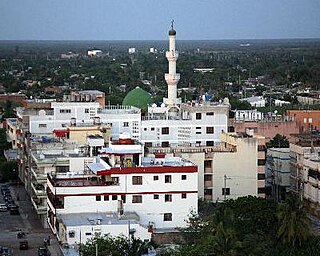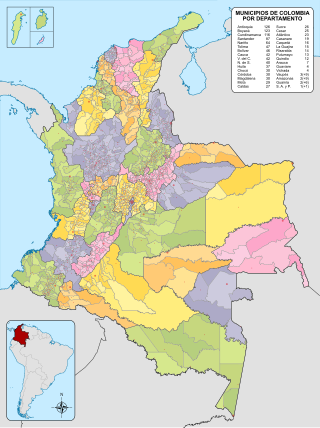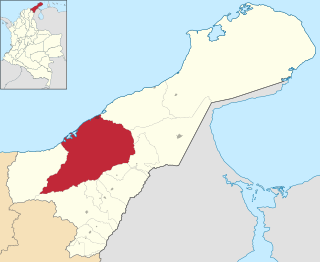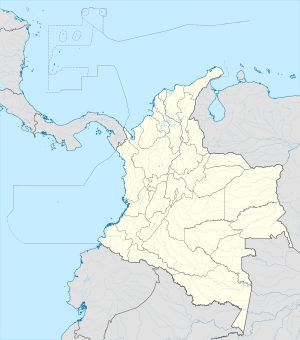
Cesar Department or simply Cesar is a department of Colombia located in the north of the country in the Caribbean region, bordering to the north with the Department of La Guajira, to the west with the Department of Magdalena and Department of Bolivar, to the south with Department of Santander, to the east with the Department of North Santander, and further to the east with the country of Venezuela. The department capital city is Valledupar.

Valledupar is a city and municipality in northeastern Colombia. It is the capital of Cesar Department. Its name, Valle de Upar, was established in honor of the Amerindian cacique who ruled the valley; Cacique Upar. The city lies between the mountains of the Sierra Nevada de Santa Marta and the Serranía del Perijá to the borders of the Guatapurí and Cesar rivers.

Riohacha is a city in the Riohacha Municipality in the northern Caribbean Region of Colombia by the mouth of the Ranchería River and the Caribbean Sea. It is the capital city of the La Guajira Department. It has a sandy beach waterfront.

Maicao is a city and municipality in the Department of La Guajira, northern Republic of Colombia. It is located 76 km from Riohacha, the capital of the department and is the second largest urban center near the border with Venezuela, after the city of Cúcuta.

The municipalities of Colombia are decentralized subdivisions of the Republic of Colombia. Municipalities make up most of the departments of Colombia with 1,122 municipalities (municipios). Each one of them is led by a mayor (alcalde) elected by popular vote and represents the maximum executive government official at a municipality level under the mandate of the governor of their department which is a representative of all municipalities in the department; municipalities are grouped to form departments.

Sogamoso is a city in the department of Boyacá of Colombia. It is the capital of the Sugamuxi Province, named after the original Sugamuxi. Sogamoso is nicknamed "City of the Sun", based on the original Muisca tradition of pilgrimage and adoring their Sun god Sué at the Sun Temple. The city is located at an altitude of 2,569 metres (8,428 ft) on the Altiplano Cundiboyacense in the Eastern Ranges of the Colombian Andes.

San Juan del Cesar is a municipality and town located in the La Guajira Department, Colombia.

The Caribbean region of Colombia or Caribbean coast region is in the north of Colombia and is mainly composed of 8 departments located contiguous to the Caribbean. It's the second most populated region in the country after Andean Region with approximately 11 million residents according to the Colombian Census 2018. The area covers a total land area of 110,000 km2 (42,000 sq mi), including the Archipelago of San Andrés, Providencia and Santa Catalina in the Caribbean Sea.

La Guajira is a department of Colombia. It occupies most of the Guajira Peninsula in the northeast region of the country, on the Caribbean Sea and bordering Venezuela, at the northernmost tip of South America. The capital city of the department is Riohacha.

The Ranchería River is a river located in northern La Guajira Department, Colombia. Born in the Sierra Nevada de Santa Marta southern steps flows south, abruptly turns northeast and then north where it finally flows into the Caribbean Sea. It is the main river of La Guajira Department and has great significance for the Wayuu people.

Fonseca is a municipality located in the Colombian Department of La Guajira. The town celebrates the Festival del Retorno in honor of St Augustine with religious celebrations, vallenato music events and others.

Uribia is a town and municipality of the La Guajira department of Colombia. It is the youngest municipality of this Department since the year 2000. Northern Zone of the Cerrejón coal mines are located in this municipality. The municipality also contains the Serranía de Macuira mountain range which is an isolated low altitude mountain range in the middle of La Guajira Desert. One third of this mountain range is also a National Natural Park of Colombia.

Albania is a town and municipality of the Colombian Department of La Guajira. Is the youngest municipality of this Department along with the town of Uribia and others, created on March 19, 2000. Albania neighbours and exclusive enclosed camp site for the Cerrejón coal mine workers and their families, named Mushaisa.

Colombian geography presents formidable challenges to roadbuilders, who need to integrate its largest production centers deep within the Andes with major ports in both the Atlantic and Pacific oceans. All of this creates a heavy premium to roadbuilding, compared with the cost of building highways in flat terrain. Therefore, the Colombian government is undertaking a great effort in order to improve the highway system, under the name of Fourth Generation Highways, with the intent of updating major roads to international safety and speed standards. This project will be funded through both public and private capital, with a total worth of nearly US$23 billion, accounting to a yearly investment of 3% of national GDP, improving or building a grand total of over 8.000 km of roads. These roads are expected to improve Colombia's competitiveness in order to successfully take advantage of the many trade agreements signed in recent years.

The 1st Division is a Colombian National Army division consisting on two brigades; The 2nd Brigade based in the city of Barranquilla and the 10th Armored Brigade based in the city of Valledupar. Its current commander is general Juan Bautista Yepez Bedoya, an infantry officer.

Atanquez or San Sebastian is a Colombian town and corregimiento of Valledupar in the Department of Cesar. Atanquez is located on the Sierra Nevada de Santa Marta mountain range at approximately 2,000 m over sea level. Atanquez is known for being predominantly inhabited by the indigenous ethnic group Kankuamos among others and mestizo groups.

Riohacha Municipality is located on the Caribbean region of Colombia of La Guajira Department, Colombia. It extends over 3,120 km2 and has an urban part divided into 10 Communes, 14 Corregimientos and 8 Resguardos Indígenas. 7 of the indigenous regions belong to the Wayuu and one in the Sierra Nevada de Santa Marta region shared by the Kogi, the Wiwa, and the Ijka, a subtribe of the Arhuaco people.

Palomino is a small town on the Caribbean coast of Colombia located in the Guajira region of Colombia, approximately 70 km from Santa Marta and 90 km from Riohacha.

Luis Antonio Robles Suárez also known as "El Negro Robles", was a Colombian lawyer and politician. He was the first Afro-Colombian to hold a cabinet-level ministry in Colombia serving as Secretary of the Treasury and Public Credit during the administration of President Aquileo Parra Gómez, as well as being the first Afro-Colombian Congressperson as Member of the Chamber of Representatives for Magdalena, and the first Afro-Colombian Governor of a Department, as the 16th President of the Sovereign State of Magdalena. He graduated a lawyer from Our Lady of the Rosary University in 1872, thus also becoming the first Afro-Colombian to ever serve as a lawyer in Colombia.
Colombia Migration is Colombia's border control agency responsible for monitoring and conducting migratory control within the framework of national sovereignty and in accordance with the law.























